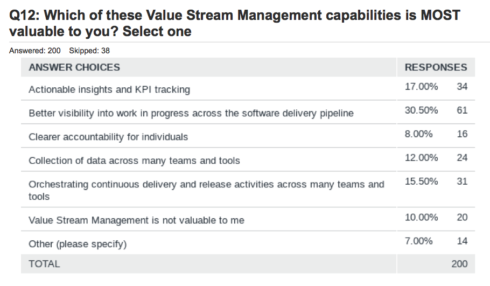
In the software development industry, value stream management (VSM) is a relatively new concept. While it’s been used in physical manufacturing for decades, it’s application within software development poses unique challenges, in that the product is always changing and — in a more esoteric sense — software development is not linear.
So it’s not surprising that a recent survey on the uptake of value stream management in development shops found that only 29% of 238 respondents are either implementing or planning to implement value stream management. Meanwhile, 33% indicated they had never even heard of the term.
“What this tells me is that this market is still quite new, and many organizations facing application modernization and digital transformation issues haven’t been able to put anything more on their plates right now,” said David Lyman, publisher of SD Times, which created the survey in conjunction with HCL Software. “But those who have started down the value stream management path are finding clear benefits.”
RELATED CONTENT:
VSM DevCon: A free virtual value stream management conference
The HCL Software DevOps portfolio expands with three major releases
“Thinking about it in the context of ‘crossing the chasm,’ where you’ve got innovators and early adopters — typically the group to the left of the chasm — I really do feel like that’s where the value stream management space is today,” said Steve Boone, head of product management, HCL DevOps Portfolio. “What the market needs to do is show the concrete value.”
When asked how they stand in terms of value stream maturity, more than 8% said they have created a value stream map in their organizations; 15% are collecting and analyzing metrics; 8% are managing multiple streams; 7% are eliminating waste and gaining efficiency; and another 7% have clear tracing of value from idea to deliverable.
Because value stream management is not a one-size-fits-all solution, respondents to the survey said they are facing challenges in implementing the practice across their organizations. Of these, 47% said their biggest challenge is a lack of experience with VSM techniques, which were developed for physical manufacturing and are now being applied to software. Another 26% said they aren’t getting executive buy-in on the business value of VSM, while 32% said they have no current funding for implementing VSM tools and techniques.
Interestingly, another 31% said they are still working on DevOps fundamentals such as CI/CD.
Yet for those who are implementing value stream management, the VSM capability that is most valuable to 30% of the respondents is better visibility into work in progress across the software delivery pipeline. Another 17% said they derive the most value from actionable insights and KPI tracking, and more than 15% said they value the orchestration of continuous delivery and release activities across many teams and tools. Further, 12% said they valued collection of data across many teams and tools, while 8% valued clearer accountability for individuals.
But visibility is only the first step in value stream management. “We can provide visibility into where the work’s going, but once you know, once you see, once you understand, what do you do?” Boone said.
In early 2018, value stream management was a zero-dollar market, and some analyst firms did not even recognize it. Today, it is projected to be a $500 million market by 2025. Boone believes the benefits will drive growth, but more is needed today. “That’s where as an industry, with education, best practices, having independent groups that aren’t software vendors, [we need to] be able to educate people and teach them what to make of the data they’re seeing and do something meaningful with it. That’s how we’re going to make that transformation.”
A episode of the What The Dev? podcast featuring Steve Boone will be available next week. Look for it in our podcast feed or wherever you listen to podcasts.






